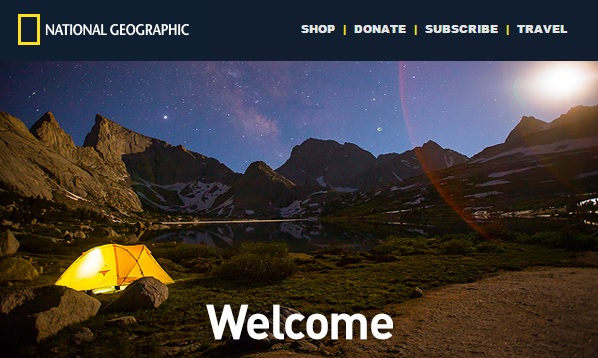I signed up for National Geographic’s newsletter on their website and received a Welcome email less than 24 hours later. The Welcome email included four calls to action including, view member benefits, see today’s photo, watch featured video, and visit the online store. The email also included a free copy of Nat Geo’s Guide to Photography e-book. The second email came two days later and asked me to identify my interests, based on Nat Geo’s newsletter categories. The email took me to an online form, where I chose five topics of interest. I have received three additional emails from Nat Geo in the first week regarding specific interests I identified in the registration process. That’s five total emails in the first seven days of signing up for the Nat Geo newsletter. Following the initial three emails, the cadence slowed down to an email every three days.
To update email preferences, users must log into their account and choose their interests. There isn’t a link to complete this action from the emails. Also not included in the emails is personalization. I expected to see my name in the Welcome email. If someone is going to ask me to donate money, I would expect them to insert my first name into the email.
The look and feel of every email are consistent across desktop and mobile. In fact, the emails render exactly the same across devices and contain the same images, content, and calls to action. Not surprising, the emails are packed full of images and links to content on the Nat Geo website. According to a recent article on Forbes.com about mobile-optimized email newsletters, “Use a single call to action. While having a strong call to action is important in every type of email you create, it’s even more important on mobile.” This statement would indicate that Nat Geo should reduce the number of calls to action to one or two, instead of four or five. That same article says, “Use images sparingly: While images can be great for adding visual interest, having too many (or having images that are too large) can wreak havoc on download times.” Nat Geo uses many photos in their emails, which causes latency when loading the email. I experienced this first hand on my mobile device. Nat Geo has an opportunity to simplify their mobile newsletters by reducing images and calls to action.
If I were designing an email for Nat Geo, I would target subscription holders that are up for renewal in the next three months. I would pull the email list from Nat Geo’s internal customer relationship management tool (CRM), run it against any opt-outs, and include personalization. I would include a header in the email with links to Shop, Watch, Read, Donate, and Learn More. I would also include a “Share” button on the subscription landing page that links to social sites with the content, “I just renewed my subscription to Nat Geo. I’m making a difference in the world.” The email would include a promotion for a free world map upon renewing by the end of this year. To test the subject line, I would run an A/B test, sending half of the list an email with the subject line below. I would send the same email to the “B” list with the subject line, “Exclusive Offer for Member’s Only.” The “A” email would include one call to action and look something like this:
Subject: Earn a FREE Gift With Your National Geographic Renewal- Limited Time!
Thank you for your subscription to National Geographic Magazine! Your support helps to fund more than 500 projects worldwide. To show our gratitude, we are offering existing members only a FREE world map when you renew your subscription. This offer is only for a limited time, so act before December 31st, 2015.
<img src=”world_map.jpg” alt=”Free World Map”> (HTML on purpose for this class)
Click here to renew your subscription and take advantage of this exclusive offer for members only.
Sincerely,
The National Geographic Team
To measure the success of the emails against campaigns goals, I would code each email so that I could track the A/B results using Google Analytics campaign tracking. Google Analytics would allow me to measure bounce rate, email open rate, # of completed subscriptions attributed to email, revenue generated from the “Shop” link, and an eCommerce conversion rate.
By Kim Carlson
Resources:
DeMers, J. (2015, April, 8). How important is a mobile-optimized email newsletter? Forbes. Retrieved from http://www.forbes.com/sites/jaysondemers/2015/04/08/how-important-is-a-mobile-optimized-email-newsletter/3/

